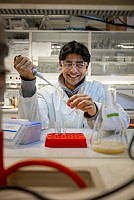Stipendiat ved institutt for kjemisk prosessteknologi Chinmay Patwardhan på lab for prosjektet iCulture som bruker bakterier for å hente ut flere nyttige stoffer/produkter fra tang og tare.
Stipendiat ved institutt for kjemisk prosessteknologi Chinmay Patwardhan på lab for prosjektet iCulture som bruker bakterier for å hente ut flere nyttige stoffer/produkter fra tang og tare.












